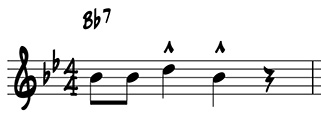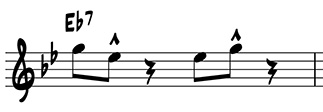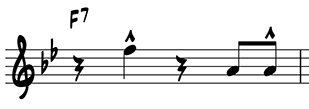Index - Introduction - Lessons
Introduction to harmony: One-measure riffs using scale degrees 1 and 3
Focus on Harmony
Lesson 1 and Lesson 2 introduced improvisation on just one pitch -- the root of each chord of the B flat blues. There are many other possible note choices in each chord, though. This lesson serves as an introduction to harmony.
Chords
A chord consists of three or more pitches played at the same time. In these exercises, we are using two different types of chords: dominant seventh chords and minor seventh chords, which consist of four notes. One way to determine the pitches of a chord is to use a scale as a guide.
Using a major scale as our starting point, the dominant seventh chord consist of the 1st, 3rd, 5th, and lowered seventh scale degrees.
Here are examples of each of the dominant seventh chords we are playing in our B flat blues. The numbers underneath the staff indicate the scale degrees.
Example of the scale degrees and chord for B flat 7:

Example of the scale degrees and chord for E flat 7:

Example of the scale degrees and chord for F 7:

The minor seventh chord consists of the 1st, lowered 3rd, 5th, and lowered 7th scale degrees. In our exercises, we are improvising on a C minor 7 chord. Here are the pitches of that chord:
Example of the scale degrees and chord for C minor 7 (usually abbreviated with a minus sign: C-7):

In this lesson, we are going to improvise using scale degrees 1 and 3 for each chord. We will get to the other chord tones later. Even though the focus of this lesson is to include another harmonic pitch, compose and improvise simple, memorable rhythms.
Part 1: Compose
Compose four unique one-measure riffs, based on the scale degrees 1 and 3 of the individual chords of the B flat blues we are using. (For free blank staff paper, visit www.Music-Paper.com)
Part 1.1: Compose a one-measure riff on scale degrees 1 and 3 of the B flat 7 chord. Here is an example of a basic jazz riff.

Part 1.2: Compose a one-measure riff on scale degrees 1 and 3 of the E flat 7 chord.

Part 1.3: Compose a one-measure riff on scale degrees 1 and 3 of the C minor 7 chord.

Part 1.4: Compose a one-measure riff on scale degrees 1 and 3 of the F7 chord.

Suggestions: The focus is on harmony in this lesson, but keep in mind the topics of Lesson 1, and write clear, simple rhythms that are memorable. You can include riffs that have scale degree 3 higher than scale degree 1 (like the first three examples above), and also have scale degree 3 lower than scale degree 1 (like the example for the F7 chord above).
Part 2: Memorize
Memorize the riffs that you have composed and play each one along with the matching recording of the sustained chords of the B flat blues. Repeat each riff many times until you can play them all effortlessly.
Part 3: Improvise
Improvise one-measure riffs on scale degrees 1 and 3 while playing along with the sustained chords for each of the chords of the B flat blues. Trade fours with yourself by improvising a one-measure riff and then repeating it three more times, improvising a new one-measure riff and repeating it three more times, etc.

Suggested exercises for solo and group practice:
Similar to the exercises in Lesson 1, you should trade fours, twos, and ones, with yourself and with other musicians. Also, trade fours with silence. Play for four measures and then rest for four measures.
Practice these pitches throughout the range of your instrument. Expand your comfort zone so that you can improvise freely on these two chord tones without having to think about the pitches.
Lesson 4: Playing scale degrees 1 and 3 on the B flat blues

If you like this site, please share it with others!


Like Kyle Coughlin Music on Facebook
Follow Kyle Coughlin Music on Twitter